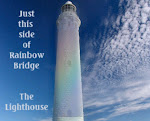His new book, Glimpses of Eternity (Guideposts, 2010; subtitled "Sharing a Loved One's Passage from This Life to the Next"), is about what he calls "shared death experiences." He first heard of one of these in medical school in 1972, when one of the professors told him what she'd experienced when her mother died. But it wasn't until the mid-1980s that he started hearing of more of them -- first from doctors and nurses, telling him about "curious events" that took place at deathbeds, and then later from more and more people outside the medical profession (something he attributed in an interview to hospice care allowing family members to be with their loved ones more often then, following a period when it wasn't unusual for doctors and nurses to ask family members to leave when a patient was dying).
And in 1994 he had a shared death experience of his own, when his mother died, and he and his wife and his two sisters and their husbands were all with her:
And as we waited, it happened to us: a shared death experience. As we held hands around the bed, the room seemed to change shape and four of the six of us felt as though we were being lifted off the ground. I had the feeling that the room had turned into the shape of an hourglass. I felt a strong pull, like a riptide that was pulling me out to sea, only the pull was upward.
"Look," said my sister, pointing to a spot at the end of the bed. "Dad's here! He's come back to get her!"
Everyone there reported later that the light in the room changed to a soft and fuzzy texture. It was like looking at light in a swimming pool at night.
As all of this took place, there was great joy in the room. We all knew something incredible had happened to all of us as our mother died. It was as though the fabric of the universe had torn and for just a moment we felt the energy of that place called heaven.
About this time, Moody says, he started being asked about shared death experiences, almost as often as he was asked about near death experiences. And as an experiment, he started asking his lecture audiences at conferences how many had had similar experiences, which he'd first describe briefly. "To my surprise," he writes, "anywhere from 5 to 10 percent of every audience would hold up their hands."
So he started devoting even more time to collecting, studying and analyzing shared death experiences.
He describes seven elements typical of shared death experiences -- though he also emphasizes that none of the shared death experiences he's studied contain all seven (he writes at the end of the chapter on these elements that no shared death account contained just one element, either; most contained several).
1) Change of geometry. This is one element that apparently is unique to shared death experiences, and not encountered in near death experiences. "For many," he writes, "this change of geometry means that the room simply seems to change shape. Others have said that the room changes shape but also opens into an 'alternate realty' that is described in various ways."
2) Mystical light. Sometimes this light, which conveys peace and love and wisdom, and also seems to have complexity and depth, fills the room. In other shared death experiences, witnesses tell of seeing the dying person's eyes lighting up, or their entire body taking on a translucent glow.
3) Music and musical sounds. These may be heard by the person who's dying as well as others present, sometimes a number of people.
4) Out-of-body experience. Moody says this is "a fairly common element in shared death experiences. During this phenomenon, a person has a strong sense that they have moved to a position from which they can observe their own physical body and all that is around it."
5) Co-living a life review. People who've had near death experiences often report life reviews. Moody found that many of those who have had shared death experiences found themselves sharing the life review of the person who was dying, in some cases becoming aware of parts of their life or people they knew that hadn't been known to them before.
6) Encountering otherworldly or "heavenly" realms. This is one of the most common elements of near death experiences, and also a common element of shared death experiences.
7) Mist at death. Moody writes that ever since he began to study death, he'd started hearing some accounts of people seeing a mist emitted from the body of a dying person -- sometimes formess, other times taking a human shape, before drifting upward and disappearing. Like the mystical light, the mist sometimes seems to have a complexity and depth. Moody admits he doesn't know what to interpret these accounts, but he doesn't dismiss this as an hallucination, especially since it's seen just as the loved one dies.
Moody writes that he's often been asked if people have to be religious to have these experiences. He says that based on his studies, he feels "confident that the experiences of believes and non-believers are essentially the same; only the interpretations may differ." He points out that this is also true of near death experiences.
On the other hand, although a particular belief system is not necessary to have a shared death experience, the experience itself is transformative -- which is also true of near death experiences.
This book, like Dr. Moody's other books, offers fascinating information -- and hope.

